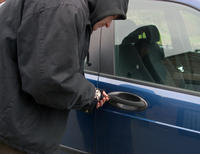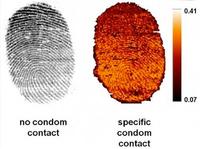-
Tampa police already training for 2012 RNC convention
In preparation for next year’s Republican National Convention in Tampa Bay Florida, nearly every local police department employee is required to attend a three-day training course; the mandatory training is designed to teach officers how to control large crowds
-
-
Auto theft going extinct?

Thanks to aggressive police work and new technology car theft could eventually become an obsolete problem; new technological developments like high-tech keys, immobilizer systems, and GPS tracking have made it increasingly difficult for thieves to successfully steal cars; new police tactics and technologies like bait cars and license plate scanners have given law enforcement agencies the edge in tracking down stolen cars and catching thieves
-
-
New fingermarks detection technology

The new technology uses Matrix Assisted Laser Desorption Ionization Mass Spectrometry Imaging (MALDI-MSI) to provide crime scene investigators with key extra details about suspects; these details, such as any substances they might have touched, can provide crucial background information in a criminal investigation
-
-
Portable biometric system for police officers

Police now have a new low-cost, portable biometric tool in their arsenal to quickly and accurately identify a suspect: an Apple iPhone; using MORIS (Mobile Offender Recognition and Information System), an app developed by BI2 Technologies, police officers can now use an Apple iPhone to scan a suspect’s fingerprint or snap a photo of their face to scan their iris
-
-
Gwinnet County, Georgia to issue instant e-tickets
In the past, in Gwinnet County, Georgia, like in many counties across the United States, residents would not see a traffic ticket on their records until several weeks later, but now thanks to new technology, police officers, fire marshals, and animal control agents will be able to issue and print citations immediately
-
-
Law enforcement and privacy concerns in Vancouver
Last month, the police in the otherwise sedate Vancouver had to use tear gas, pepper spray, and flash bombs in downtown Vancouver to try to disperse angry rioters who set cars on fire, looted stores, and taunted police officers after the Canucks’ 4-0 Stanley Cup final loss to the Boston Bruins; the police wants to use facial recognition technology to identify the rioters, but privacy advocates are worried
-
-
Law enforcement and privacy concerns in Massachusetts
Massachusetts has a plan: create a database which could map drivers’ whereabouts with police cruiser-mounted scanners that capture thousands of license plates per hour — and store that information indefinitely so local police, state police, federal agencies, and prosecutors could access it as they choose; privacy advocates are worried
-
-
Taser, Metal Storm collaborate on less lethal ammunition

TASER International has entered into a Memorandum of Understanding (MoU) with Metal Storm Limited and to develop and market TASER less-lethal ammunition for the Metal Storm MAUL weapon; Metal Storm’s MAUL weighs 800 grams can be fitted as an accessory to an assault rifle, or operated from its own shoulder stock or pistol grip attachments
-
-
FBI now free to search your trash?
FBI agents will soon have heightened investigative powers that would allow them to delve more deeply into databases, rummage through an individuals’ trash, or place surveillance teams on suspects; in the upcoming release of the Domestic Investigations and Operations Guide, the FBI’s manual, agents will be given greater leeway in searching for evidence of criminal or terrorist activity
-
-
After FBI arrests LulzSec announces more cyber mayhem
In response to the FBI’s arrest of several hackers, the recently disbanded hacking group known as LulzSec has vowed to return and the group says it will renew its attacks on corporations and government agencies; the announcement comes after U.S. authorities arrested sixteen people last week in relation to the groups’ previous attacks which included bringing down PayPal’s website after it suspended its service to WikiLeaks
-
-
Test for classifying force used in bottle stabbings developed
Stabbing is the most common method of committing murder in the United Kingdom; in approximately 10 percent of all assaults resulting in treatment in the U.K. emergency units, glasses and bottles are used as weapons; official UK estimates suggest that a form of glass is used as a weapon in between 3,400 and 5,400 offenses per year; engineers at the University of Leicester have for the first time created a way of measuring how much force is used during a stabbing using a broken bottle
-
-
Lawmakers blast the Federal Protective Service
Last week lawmakers held a hearing to investigate the Federal Protective Service’s (FPS) progress in addressing its ongoing problems; the agency has made little progress drawing the ire of lawmakers; in recent years, FPS has suffered from a series of high-profile security failures
-
-
NPIA rolls out mobile fingerprint technology
New mobile fingerprint readers allow police in England and Wales to check an individual’s fingerprint against a national database — and do so in two minutes; more than half the forces in England and Wales have already received the new devices
-
-
Private contractors outnumber government security two to one

A recent survey found that the number of private security contractors outnumber police officers two to one around the world; in some countries, the difference between private security contractors and law enforcement officials is even more significant; the report also noted several critical emerging issues as a result of the increasing use of private contractors including oversight, the role of government, and concerns for public safety
-
-
DHS seizes ancient Egyptian relics in smuggling bust

Last Thursday DHS officials made an announcement that seemed more fitting for a Hollywood movie — agents had broken up an antiques smuggling ring that had illegally shipped ancient Egyptian artifacts to the United States; among the confiscated goods was a sarcophagus that dated back to the seventh century B.C.
-
More headlines
The long view
How Male Grievance Fuels Radicalization and Extremist Violence
Social extremism is evolving in reach and form. While traditional racial supremacy ideologies remain, contemporary movements are now often fueled by something more personal and emotionally resonant: male grievance.
